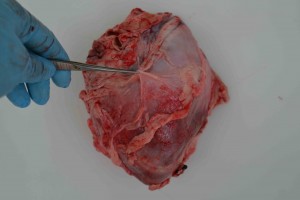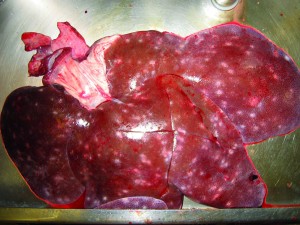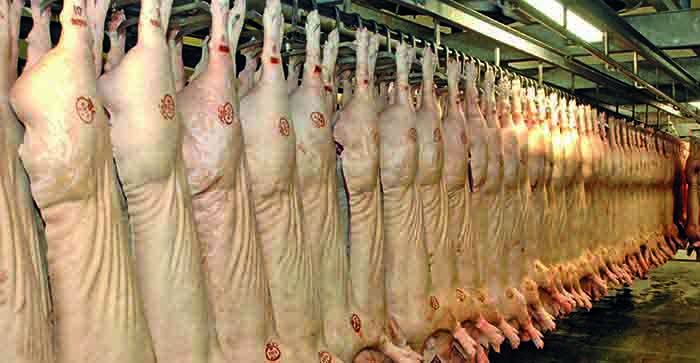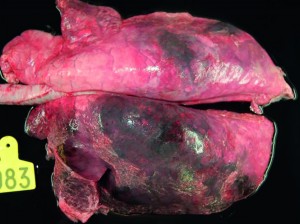As the newly named Pig Health Scheme is relaunched, AHDB outlines the benefits it delivers to producers
Producers can get information on diseases they may not be aware of, or may have accepted as ‘liveable with’ on their units, through the updated Pig Health Scheme, the successor to the British Pig Health Scheme (BPHS). Measuring the levels of these conditions on farms may help to reduce those unexplained falls in performance that seem to have no cause.
The scheme is free of charge and easy to sign up to, so producers can quickly start to see the benefit. Pigs are assessed at slaughter by trained veterinary assessors, looking at 12 different conditions in the lungs, heart, liver, tail and skin. Producers will receive a report on pigs from their unit that have been sent to slaughter. This should be discussed with the unit’s vet, so they can take steps to get ahead of any disease before it becomes a greater problem.
Further information and details of assessment dates for each abattoir will be available by the end of the year.
Producer Tom Allen, who finishes 600 pigs per week and was a member of the previous BPHS, said: “A health scheme like this is an invaluable management tool. The ongoing monitoring helped safeguard pig health and enabled us to be proactive. If we spotted a change in our BPHS reports we could dig a bit deeper to find out what might be causing an issue and do something about it before the problem snowballed.

“For example, the abattoir assessments were showing higher levels of pericarditis (pictured), so we discussed it with our vet and started vaccinating against Glässer’s disease. We were then able to start watching the incidence of pericarditis reduce over time and see how well the vaccination programme was working.”
AHDB Pork processing projects manager Lauren Turner added: “Where there are no visible signs that confirm the presence of some diseases, or where visible signs are considered the ‘norm’ on your farm, it can be hard to determine disease prevalence. They can cause producers to gradually lose money over time, by reducing growth rates, for example.
“We’re urging all producers to take advantage of the free, updated service, simply by registering to receive their herd’s Pig Health Scheme report, which can be done using their online Pig Hub account, already used for pig movements.
“Your pigs may have already been screened at the abattoir but you do not receive the health report until you have registered with AHDB. It’s a massive opportunity to find out how your herd health is really faring – and the only additional work involved is to review the information delivered to you during routine meetings with your vet, and act on it if required.

“Regular, active health planning with your vet is the most cost-effective way to reduce disease and improve welfare. The Pig Health Scheme information provides solid evidence to add to your discussions.
“It can also be used as a resource to monitor the effects of any changes, for example, relating to feed or vaccination programmes. To complete the full picture of what’s happening in your herd, you can look at the Pig Health Scheme’s post- mortem information alongside antibiotic use patterns recorded on eMB-Pigs, as well as physical performance data.”
As readers may already be aware, in October last year AHDB took the decision to temporarily stop the existing BPHS to allow a review of all aspects of the scheme.
Miss Turner said: “During this break we visited all BPHS participating abattoirs to ensure the scheme operates in the best way possible. We appreciate the help we received during this time from all teams working at the abattoirs.
“We have also revised and improved the report received by producers, and a small group of experienced vets have reviewed the way health conditions will now be scored, to ensure consistency and accuracy.”
The Pig Health Scheme has benefits for both processors, via reduced processing and condemnation costs, and producers, who get the insight they need to keep ahead of health issues. Ultimately, the aim is to improve the health and welfare of pigs and to help reduce production losses throughout the supply chain.
REVEALING COSTLY PROBLEMS
The 12 conditions monitored can lead to reduced performance and downgrading of a carcase with resultant financial penalties. These are just a few examples.
Enzootic pneumonia (EP) is detected in the abattoir as dark purple/grey lesions and rubbery consolidated areas in the lungs. Affected pigs have a mild, but long-standing, cough, which may go largely unnoticed. However, these animals have reduced and variable growth and are more prone to other infections.
Pleuritis, sometimes known as pleurisy, is inflammation of the lung surface and affected areas can also stick to the chest wall, potentially causing pain to the pig and increasing the amount of trimming required by the processors. In a recent study, when EP and pleuritis were seen together, they resulted in a 2.53kg reduction in slaughter weight for each affected pig.
In pigs with damaged tails, most often caused by tail biting, weight gain and carcase weight are reduced and, in severe cases where infection spreads, it may lead to condemnation of the whole carcase. Therefore, it is important to monitor trends and any changes in levels to try to work out where and when to take action. If tail- biting is an issue in a herd, producers can use the WebHAT, AHDB’s online tool, to help reduce the risks of tail-biting – it helps identify tail-biting risks specific to their unit and provides practical suggestions to help develop action plans to reduce tail-biting.
WHAT MEMBERS RECEIVE
Pig Health Scheme members receive three different report sheets:
Individual batch report: Summary data from the pigs inspected at the abattoir with graphical representations. Sent to producers within 48 hours of the abattoir assessment. Unit comparison report: A comparison between your units and all other units monitored during the latest quarterly monitoring period, sent at the end of the quarter.
Time comparison report: A comparison of historical data for the unit on a rolling basis of up to two years (once data is available). This will be sent at the end of each quarter. A short guidance document is available to help producers get the most out of the data in the report. It highlights how to easily tell if there is cause for concern.
Importantly, producers should not just interpret the report on its own. Rather, the results should be used alongside the production data and health of the particular batch. In all cases, it is recommended to discuss the information further with the vet.
THE CONDITIONS BEING MONITORED
The Pig Health Scheme assessor checks for incidence and severity of the following conditions in key parts of the carcase:
LUNGS
- Enzootic pneumonia-like lesions
- Viral-like lesions
- Pleuropneumonia
- Pyaemia
- Pleuritis
- Abscesses
HEART
- Pericarditis
LIVER
- Milk spot
- Hepatic scarring
- Peritonitis
TAIL
- Damaged tails
SKIN
- Papular dermatitis
How to join the Pig Health Scheme
Pig producers can join the Pig Health Scheme through their Pig Hub account, using the same log-in details as for the eAML2 system, at www.pighub.org.uk Members will then start to receive reports once assessments at their abattoir begin.
For more information, contact Lauren Turner: lauren.turner@ahdb.org.uk or 02476 478977.





